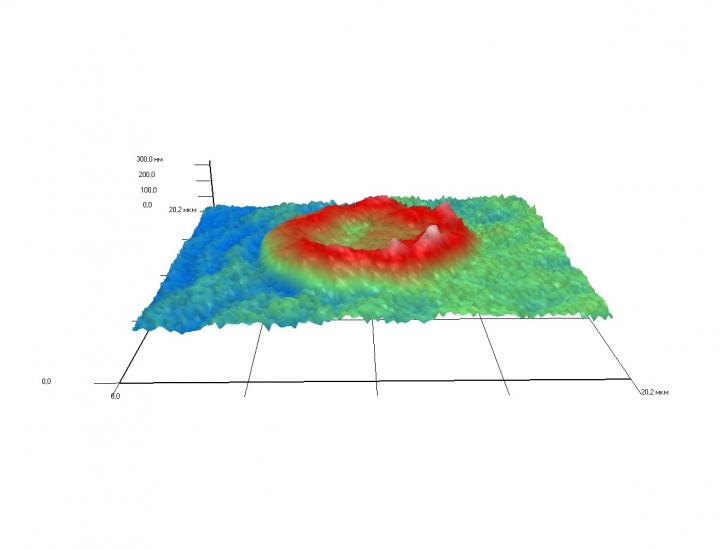Russian scientists show changes in the erythrocyte nanostructure under stress

Erythrocyte in the process of adaptation. Credit: Lobachevsky University
Various stress effects make an integral part of modern life, and their minimization is of particular relevance. Currently, much attention is being paid to the study of the structural-metabolic and functional status of erythrocytes, since they serve as a kind of “cell dosimeter” to signal stress reactions and the action of facultative and obligatory exogenous and endogenous factors that cause various diseases.
Erythrocytes (red blood cells) make up about 40-45% of the total blood volume of an adult. They are among the most numerous cells in the human body accounting for approximately 10% of the total cell volume of an adult organism. Under the action of oxidative stress, somatic shock, various medicinal substances, xenobiotics and pathologies, erythrocytes may be subjected to damage that triggers their programmed death (eryptosis).
The deterioration of the erythron state plays a significant role not only in the specific gas transport function, but also in the regulation of the acid-base state, the water-electrolyte balance, the micro-rheological status of the blood, in immune reactions, in the binding and transfer of infection agents and medicinal substances.
According to Anna Deryugina, Head of Department of Physiology and Anatomy at the Institute of Biology and Biomedicine, Lobachevsky University of Nizhny Novgorod, the study of the state of erythrocytes and early diagnosis of their changes is very important for analyzing the state of microcirculation.
Microvasculature disorders are characteristic of a number of diseases, including atherosclerosis, coronary heart disease, and arterial hypertension. Further understanding of the mechanisms behind the changes in the state of erythrocytes under various types of effects will enable the development of optimal treatment regimens for patients and the implementation of timely preventive measures.
A group of scientists from Nizhny Novgorod and Yekaterinburg is currently searching for new methods to analyze the state of cells. One of the promising modern approaches allowing a detailed study of the morphological and functional state of cells is the method of phase-modulation laser interference microscopy, which is used to study the dynamics of changes in the shape of the cell and its structure, as well as the functional state of erythrocytes.
“In our studies, visualization of erythrocytes using phase-modulation laser interference microscopy showed a change in the erythrocyte nanostructure under stress, which was accompanied by the emergence of morphologically altered cells. By constructing phase pictures of erythrocytes (3D models), we were able to estimate the intensity level of oxidative processes, which are inevitable companions of stress,” notes Anna Deryugina.
In the course of the research, the relationship between changes in the erythrocyte morphology and modification of the membrane protein-lipid structure was shown, which manifested itself in a change in the electronegativity of the erythrocyte surface. In turn, the analysis of the electrophoretic mobility of erythrocytes, depending on the direction of the process, made it possible to judge about the development of stress with an increase in cytotoxicity or about adaptive changes in the body with genetic damage repair.
“Thus, the analysis of the electrokinetic characteristics of erythrocytes and their visualization can provide a diagnostic criterion for the homeostasis of the organism as a whole. In other words, by using phase-modulation laser interference microscopy, one can quickly visualize membrane deformations and evaluate the state of the cells. This method can be used to diagnose and study the functioning of erythrocytes,” concludes Anna Deryugina.
Scientists note that erythrocyte visualization can become a form of rapid diagnosis of the body's condition that can be used successfully in clinical laboratories.
Media Contact
All latest news from the category: Life Sciences and Chemistry
Articles and reports from the Life Sciences and chemistry area deal with applied and basic research into modern biology, chemistry and human medicine.
Valuable information can be found on a range of life sciences fields including bacteriology, biochemistry, bionics, bioinformatics, biophysics, biotechnology, genetics, geobotany, human biology, marine biology, microbiology, molecular biology, cellular biology, zoology, bioinorganic chemistry, microchemistry and environmental chemistry.
Newest articles

Properties of new materials for microchips
… can now be measured well. Reseachers of Delft University of Technology demonstrated measuring performance properties of ultrathin silicon membranes. Making ever smaller and more powerful chips requires new ultrathin…

Floating solar’s potential
… to support sustainable development by addressing climate, water, and energy goals holistically. A new study published this week in Nature Energy raises the potential for floating solar photovoltaics (FPV)…

Skyrmions move at record speeds
… a step towards the computing of the future. An international research team led by scientists from the CNRS1 has discovered that the magnetic nanobubbles2 known as skyrmions can be…





















